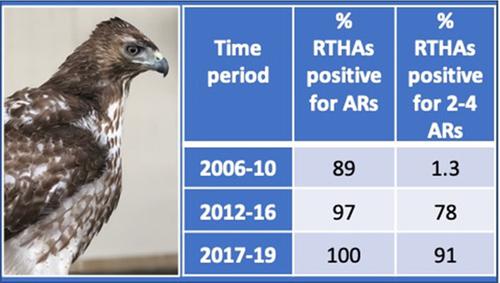当前位置:
X-MOL 学术
›
Environ. Toxicol. Chem.
›
论文详情
Our official English website, www.x-mol.net, welcomes your feedback! (Note: you will need to create a separate account there.)
Continued Anticoagulant Rodenticide Exposure of Red‐tailed Hawks (Buteo jamaicensis) in the Northeastern United States with an Evaluation of Serum for Biomonitoring
Environmental Toxicology and Chemistry ( IF 4.1 ) Pub Date : 2020-08-17 , DOI: 10.1002/etc.4853 Maureen Murray 1
Environmental Toxicology and Chemistry ( IF 4.1 ) Pub Date : 2020-08-17 , DOI: 10.1002/etc.4853 Maureen Murray 1
Affiliation

|
Prior studies (2006–2016) in birds of prey admitted to a wildlife clinic in Massachusetts, USA, revealed widespread exposure to second‐generation anticoagulant rodenticides (SGARs) among red‐tailed hawks (Buteo jamaicensis, RTHAs). Continued monitoring of species for which historic data are available can reveal trends in exposure that aid in evaluating the effectiveness of risk‐mitigation measures. While the majority of exposure‐monitoring studies utilize liver tissue collected postmortem, antemortem modalities, such as serum analysis, may be desirable for risk assessments in certain populations. However, the sensitivity of serum for detecting anticoagulant rodenticides (ARs) is not well studied. Paired liver and serum samples from 43 RTHAs were evaluated from 2017 to 2019. In liver tissue, 100% of birds were positive for ARs, with the SGARs brodifacoum, bromadiolone, and difethialone identified most frequently; 91% of birds had liver residues of 2 to 4 ARs. These findings represent the highest exposure both to ARs overall and to multiple ARs in RTHAs compared to previous studies. All birds diagnosed with AR toxicosis (n = 14) were positive for ARs in serum; however, all subclinically exposed birds (n = 29) were negative in serum. These data show that exposure to SGARs remains widespread in RTHAs in this geographic area. In addition, although serum analysis is not sensitive for detecting sublethal exposures in RTHAs, it can potentially support a diagnosis of AR toxicosis in conjunction with other consistent signs. Environ Toxicol Chem 2020;39:2325–2335. © 2020 SETAC
中文翻译:

评估美国东北部红尾鹰(Buteo jamaicensis)的抗凝杀鼠剂持续暴露情况并评估其血清的生物监测能力
对美国马萨诸塞州一家野生动物诊所收养的猛禽的先前研究(2006-2016年)显示,红尾鹰(Buteo jamaicensis)广泛接触第二代抗凝灭鼠剂(SGAR),RTHA)。持续监测可获得历史数据的物种可以揭示暴露趋势,从而有助于评估风险缓解措施的有效性。虽然大多数的暴露监测研究利用死后收集的肝组织,但在某些人群中进行风险评估前可能需要进行死前检查,例如血清分析。但是,血清对检测抗凝灭鼠剂(ARs)的敏感性尚未得到很好的研究。从2017年至2019年,对43份RTHA的配对肝和血清样本进行了评估。在肝组织中,100%的禽类的AR呈阳性,其中最常见的是SGARs昔布古丁,溴苯丙隆和地非噻隆。91%的禽鸟的肝残留量为2-4 ARs。与以前的研究相比,这些发现代表了在RTHA中,AR整体和多个AR的暴露最高。所有被诊断出患有AR中毒的鸟类(n = 14)血清中ARs阳性;但是,所有亚临床暴露的鸟类(n = 29)的血清均为阴性。这些数据表明,在该地理区域的RTHA中,SGAR的暴露仍然很普遍。此外,尽管血清分析对检测RTHA中的亚致死剂量并不敏感,但它可能支持与其他一致体征一起诊断AR中毒。2020年《环境毒理学》; 39:2325–2335。©2020 SETAC
更新日期:2020-10-26
中文翻译:

评估美国东北部红尾鹰(Buteo jamaicensis)的抗凝杀鼠剂持续暴露情况并评估其血清的生物监测能力
对美国马萨诸塞州一家野生动物诊所收养的猛禽的先前研究(2006-2016年)显示,红尾鹰(Buteo jamaicensis)广泛接触第二代抗凝灭鼠剂(SGAR),RTHA)。持续监测可获得历史数据的物种可以揭示暴露趋势,从而有助于评估风险缓解措施的有效性。虽然大多数的暴露监测研究利用死后收集的肝组织,但在某些人群中进行风险评估前可能需要进行死前检查,例如血清分析。但是,血清对检测抗凝灭鼠剂(ARs)的敏感性尚未得到很好的研究。从2017年至2019年,对43份RTHA的配对肝和血清样本进行了评估。在肝组织中,100%的禽类的AR呈阳性,其中最常见的是SGARs昔布古丁,溴苯丙隆和地非噻隆。91%的禽鸟的肝残留量为2-4 ARs。与以前的研究相比,这些发现代表了在RTHA中,AR整体和多个AR的暴露最高。所有被诊断出患有AR中毒的鸟类(n = 14)血清中ARs阳性;但是,所有亚临床暴露的鸟类(n = 29)的血清均为阴性。这些数据表明,在该地理区域的RTHA中,SGAR的暴露仍然很普遍。此外,尽管血清分析对检测RTHA中的亚致死剂量并不敏感,但它可能支持与其他一致体征一起诊断AR中毒。2020年《环境毒理学》; 39:2325–2335。©2020 SETAC



























 京公网安备 11010802027423号
京公网安备 11010802027423号